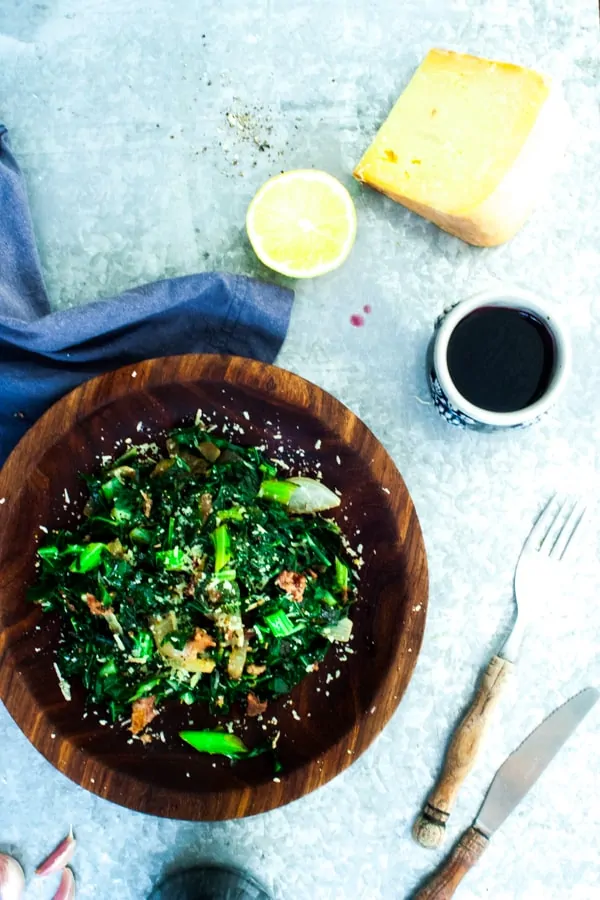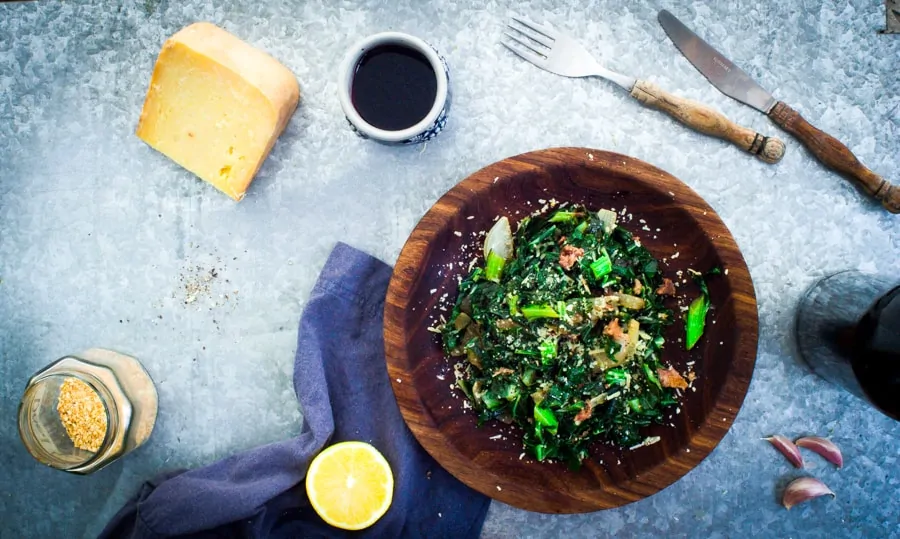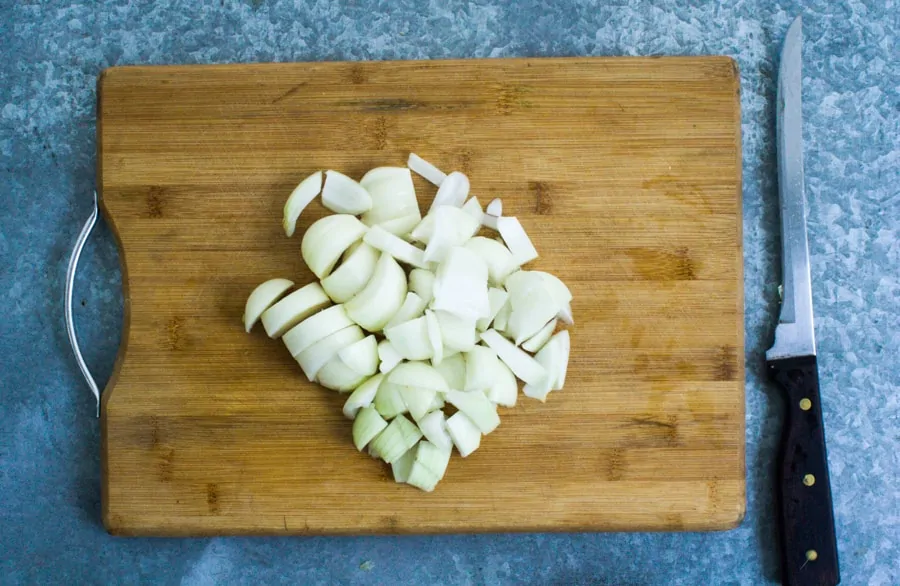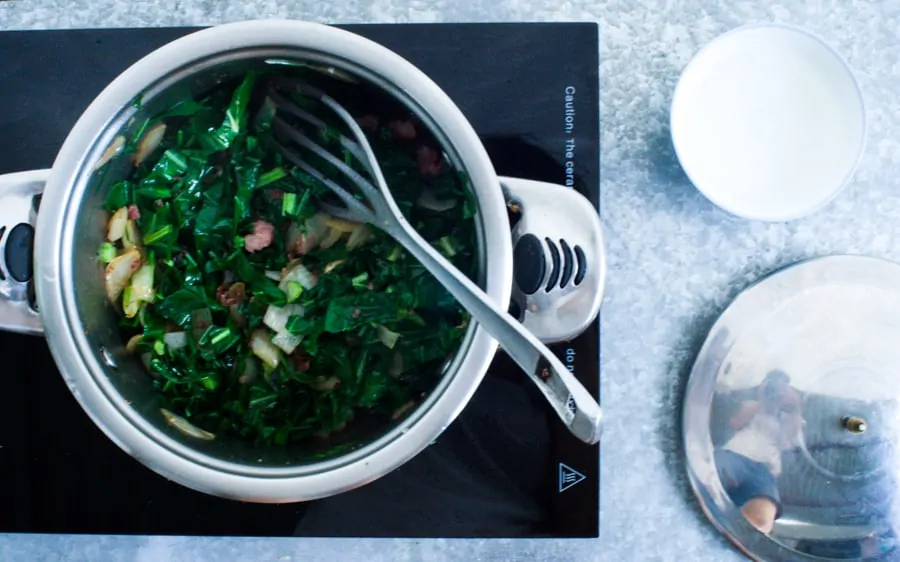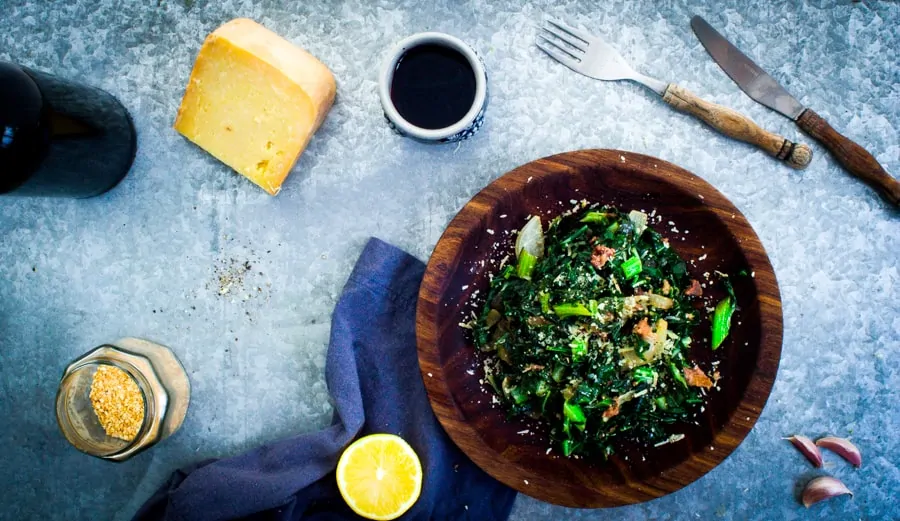A classic in Southern cuisine, collard greens are something that just about everyone has tasted at some point in their life. However, while collard greens may often be overlooked as merely an old school, traditional dish – they have so much to offer in the kitchen. And, they have a pretty interesting history.
Belonging to the brassica family, collard greens are cousin to kale, cabbage, broccoli and cauliflower. Their cultivar group name means ‘without a head’, and are loosely considered to be a headless cabbage.
Collard greens are incidentally a prehistoric vegetable, and their existence dates back thousands of years.
Originally naturally occurring in the Eastern Mediterranean, over time collard greens spread down into Africa, Central Europe, and America. Their popularity in Southern cuisine is thanks to the African tradition and heritage of cooking leafy greens.
Now, collard greens are so popular that they are the State vegetable of South Carolina. As well as being a staple side to Brazil’s national dish, Feijoada, and being eaten in Spain, Zimbabwe, East Africa and Kashmir.
The global popularity of the humble, prehistoric, and headless cabbage, is quite understandable. Because If cooked right, collards can be a super tasty green, and make for a great side dish. Like spinach and kale, you can pair collard greens with a variety of flavors and ingredients.
There are also a number of ways that you can cook collard greens. They can be broiled, sauteed, braised, simmered or stewed.
If you have looked at a lot of recipes for collard greens, you will see that cook times vary greatly. You can cook collard greens for anywhere from 15 minutes, to 3 hours. Longer cook times will result in the collard greens being softer, with an almost silky texture. Shorter cook times will render the collard greens more al dente, with some bite to them.
For our bacon, parmesan and lemon zest collard greens, we are going to be using a short cook time of 20 minutes. This makes the recipe one that you can make on any old week night. The short cook time also retains some of the collard green’s bright color, and stops them from becoming overly soft and losing all of their structure.
However, if you are not fond of vegetables cooked al dente style, and you want the collard greens nice and soft, feel free to increase the cooking time to your liking.
In this recipe we are going to be sauteing and streaming the collards, and adding bacon bits, a small amount of parmesan cheese, lemon zest, and garlic. Bacon bits are a classic addition to collard greens, as they infuse the dish with savoriness. Parmesan is not a classic addition to collards. But one that works. The stinky umami notes from the parmesan emphasize the smokey bacon flavors. To balance out these rich and heavy flavors, at the very end we will add lemon zest and a small amount of crushed garlic.
The result? A super savory smoky flavored bowl of collards, cut through with a bright zing from the lemon and a soft bite from the garlic. Eating greens just got even better folks.
And speaking of greens, it turns out that collard greens pack such a nutritional punch, that they rival kale as a super food. In fact, collards contain higher amounts of fibre and protein than kale. Watch out kale, collards may just be here to bump you off the superfood throne!
Before we jump on into the recipe, let’s quickly talk buying and washing instructions. Collard greens are in season during the colder months, so this is the time when you can buy them at their freshest. When selecting out collard greens at the store, a good tip to keep in mind, is to go for the slightly smaller bunches if possible. While massive collards look amazing, they can be tougher and more bitter than their younger, small leaved counterparts.
Once you have gotten the collards home, or are ready to cook with them, the next thing to do is wash them thoroughly. Collard greens are generally grown in sandy soil. And sand and grit can get stuck on the leaves. Even pre washed collard leaves can still retain some sand within their folds.
To remove any sand, fill your sink ¾ full of luke warm water, add ¼ cup vinegar, and the collard greens. Allow them to soak for up to 45 minutes, agitating the leaves to loosen any dirt. Then rinse well under cold water. If the collard greens that you bought are almost completely free of any sand, you can reduce the soak time to 10 or 15 minutes. Just make sure that they are 100% clean, because nothing ruins a dish like crunching on sand!
And now let’s crack on with the recipe, so that you can be eating smokey bacon flavored collard greens as soon as possible.

Collard Greens With Bacon, Parmesan and Lemon Zest
Ingredients
- 2 medium sized onions
- 400-500 grams collard greens
- 3 cloves garlic
- 1 lemon
- 100 grams bacon bits you can also use strips of bacon and chop them up
- 1 tablespoon grated parmesan cheese
- Olive oil for frying
- ¼ cup water or stock
- Salt to taste
- Pepper to taste
Instructions
-
The first thing to do is assemble all of your ingredients. If you are using a block of ungrated parmesan, you can grate off 1 flat tablespoon of shavings and put this aside to add to the recipe at the end.
-
To prep the vegetables begin by peeling and thickly slicing the onions.
-
Next up it's time to prep the collards. The first thing to do is the remove the thick rib from the centre by slicing it out. You can leave the upper portion of the rib, where it is thinner. Then slice up the collard leaves into ribbons, and dice up the ribs.
-
Now peel and crush the garlic. You can also grate it finely if you do not have a garlic crusher on hand. At the same time take the lemon and grate off a small amount of lemon zest, approximately one half’s worth.
-
Place a medium sized pot onto the heat, and add enough olive oil to cover the bottom. Bring up to heat and add the bacon bits in three lots to prevent the bacon from making water. Fry on a medium high heat until the bacon shows signs of crisping on the edges. Remove the bacon from the pot, retaining the oil, and set aside.
-
Maintaining a medium high heat, add the chopped onion to the pot. Saute until al dente but cooked.
-
Now place the collard greens into the pot, re-add the bacon and sprinkle in ¾ teaspoon of salt. Toss to coat, and saute lightly a few seconds. Now add ¼ cup of water or stock, cover, and reduce the heat to medium low. Cook for approximately 20 minutes, checking intermittently to see if the pot still has enough water to steam and not burn on the bottom. If you see that it is sticking on the bottom, add a little more water or stock.
-
Once the collards are fully cooked, turn off the heat and add in the parmesan, lemon zest, grated garlic, and any additional salt and pepper to taste. Lastly, squeeze over some of the juice from one half of the lemon from which you grated the zest.
-
Once you have added the last ingredients, all that is left to do is serve up your collards. Collard greens go really well with just about any meat dish, and of course pair perfectly with practically all Southern cuisine style dishes. Cornbread is an ideal side to serve along with collard greens, and you can use to soak up any juices. And if you don’t have any corn bread, feel free to try using any alternative bread that is nice.
Notes: Collard greens will keep in the stove while you are preparing other dishes, so do not be afraid to make them first while assembling any other components of your meal, or maybe recieving guests. They are of course the most tasty if served hot, so be sure to warm the collard greens up briefly before serving, if they have been resting. Leftover collard greens will keep in the refridgerator for up to 3 days. They can be reheated and served, or incorporated into a soup or stew.
STEP ONE – ASSEMBLE ALL INGREDIENTS
The first thing to do is assemble all of your ingredients. If you are using a block of ungrated parmesan, you can grate off 1 flat tablespoon of shavings and put this aside to add to the recipe at the end.
STEP TWO – PEEL AND CUT THE ONION
To prep the vegetables begin by peeling and thickly slicing the onions.
STEP THREE – DE-RIB AND CHOP THE COLLARD GREENS
Next up it’s time to prep the collards. The first thing to do is the remove the thick rib from the centre by slicing it out. You can leave the upper portion of the rib, where it is thinner. Then slice up the collard leaves into ribbons, and dice up the ribs.

STEP FOUR – CRUSH THE GARLIC AND GRATE THE LEMON ZEST
Now peel and crush the garlic. You can also grate it finely if you do not have a garlic crusher on hand. At the same time take the lemon and grate off a small amount of lemon zest, approximately one half’s worth.


STEP FIVE – FRY THE BACON UNTIL SLIGHTLY CRISPY
Place a medium sized pot onto the heat, and add enough olive oil to cover the bottom. Bring up to heat and add the bacon bits in three lots to prevent the bacon from making water. Fry on a medium high heat until the bacon shows signs of crisping on the edges. Remove the bacon from the pot, retaining the oil, and set aside.

STEP SIX – SAUTE THE ONIONS UNTIL AL DENTE
Maintaining a medium high heat, add the chopped onion to the pot. Saute until al dente but cooked.

STEP SEVEN – ADD THE COLLARDS AND BACON AND STEAM
Now place the collard greens into the pot, re-add the bacon and sprinkle in ¾ teaspoon of salt. Toss to coat, and saute lightly a few seconds. Now add ¼ cup of water or stock, cover, and reduce the heat to medium low. Cook for approximately 20 minutes, checking intermittently to see if the pot still has enough water to steam and not burn on the bottom. If you see that it is sticking on the bottom, add a little more water or stock.
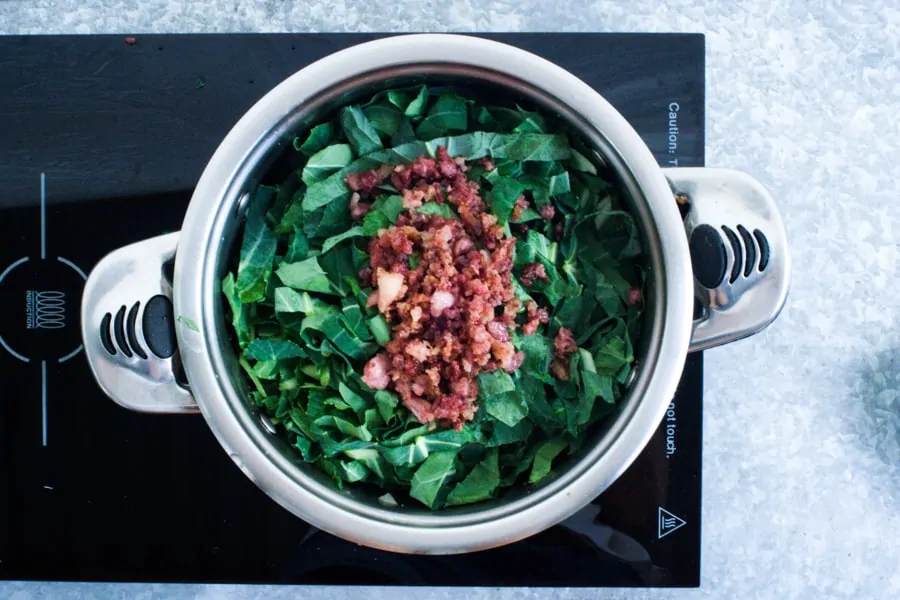
STEP EIGHT – ADD THE PARMESAN, GARLIC AND LEMON ZEST
Once the collards are fully cooked, turn off the heat and add in the parmesan, lemon zest, grated garlic, and any additional salt and pepper to taste.
STEP NINE – SERVE
And the last thing you need to do is serve up the collard greens!
Collard greens will keep in the stove while you are preparing other dishes, so do not be afraid to make them first while assembling any other components of your meal, or maybe recieving guests. They are of course the most tasty if served hot, so be sure to warm the collard greens up briefly before serving, if they have been resting. Leftover collard greens will keep in the refridgerator for up to 3 days. They can be reheated and served, or incorporated into a soup or stew.
Collard greens make for a nutritious, and flavorful side that can be paired with a just about anything, as they go well with any meat, especially pork. A classic southern pairing for collard greens is cornbread, as you can use it to soak up some of the excess juice.
If you are feeling like a simple meal, you could even eat this dish over a bed of rice, or on its own for a low carb option.
You can also serve collard greens at just about anytime of the year. However, they will be nicest and cheapest in winter and spring, which is why collard greens are typically cooked during the colder months.
Do you have a favorite dish to pair with collard greens? Or a favorite time to serve them? Or a great way to cook with them? If so, let us know in the comments!
Jen Miller is a former electrical engineer and product specialist with more than 20 years of product design and testing experience. She has designed more than 200 products for Fortune 500 companies, in fields ranging from home appliances to sports gear and outdoor equipment. She founded Jen Reviews to share her knowledge and critical eye for what makes consumers tick, and adopts a strict no-BS approach to help the reader filter through the maze of products and marketing hype out there. She writes regularly and has been featured on Forbes, Fast Company, The Muse, The Huffington Post, Tiny Buddha and MindBodyGreen.
